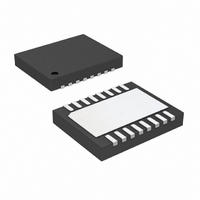LTC3783EDHD#TRPBF Linear Technology, LTC3783EDHD#TRPBF Datasheet - Page 17

LTC3783EDHD#TRPBF
Manufacturer Part Number
LTC3783EDHD#TRPBF
Description
IC LED DRIVER PWM CONTROL 16-DFN
Manufacturer
Linear Technology
Type
PWM Controlr
Datasheet
1.LTC3783EFEPBF.pdf
(24 pages)
Specifications of LTC3783EDHD#TRPBF
Constant Current
Yes
Constant Voltage
Yes
Topology
Flyback, PWM, SEPIC, Step-Down (Buck), Step-Up (Boost)
Number Of Outputs
1
Internal Driver
No
Type - Primary
Automotive, General Purpose
Frequency
20kHz ~ 1MHz
Voltage - Supply
3 V ~ 36 V
Mounting Type
Surface Mount
Package / Case
16-DFN
Operating Temperature
-40°C ~ 85°C
Internal Switch(s)
No
Lead Free Status / RoHS Status
Lead free / RoHS Compliant
Voltage - Output
-
Current - Output / Channel
-
Efficiency
-
Available stocks
Company
Part Number
Manufacturer
Quantity
Price
OPERATION
From a known power dissipated in the power MOSFET, its
junction temperature can be obtained using the following
formula:
The θ
θ
case to the ambient temperature (θ
can then be compared to the original, assumed value used
in the iterative calculation process.
Boost Converter: Output Diode Selection
To maximize effi ciency, a fast switching diode with low
forward drop and low reverse leakage is desired. The output
diode in a boost converter conducts current during the
switch off-time. The peak reverse voltage that the diode
must withstand is equal to the regulator output voltage.
The average forward current in normal operation is equal
to the output current, and the peak current is equal to the
peak inductor current.
The power dissipated by the diode is:
and the diode junction temperature is:
The θ
θ
board to the ambient temperature in the enclosure.
Remember to keep the diode lead lengths short and to
observe proper switch-node layout (see Board Layout
Checklist) to avoid excessive ringing and increased
dissipation.
Boost Converter: Output Capacitor Selection
Contributions of ESR (equivalent series resistance), ESL
(equivalent series inductance) and the bulk capacitance
must be considered when choosing the correct component
JC
JC
T
P
T
I
D PEAK
J
J
D
for the device plus the thermal resistance from the
for the device plus the thermal resistance from the
(
= T
= T
JA
JA
= I
to be used in this equation normally includes the
to be used in this equation normally includes the
A
OUT(MAX)
A
)
+ P
+ P
=
I
FET
D
L PEAK
(
• θ
• θ
• V
JA
JA
)
D
=
⎛
⎝ ⎜
1
+
χ
2
⎞
⎠ ⎟
•
I
1
OUT MAX
–
CA
D
(
). This value of T
MA
X X
)
J
for a given output ripple voltage. The effects of these three
parameters (ESR, ESL and bulk C) on the output voltage
ripple waveform are illustrated in Figure 9 for a typical
boost converter.
The choice of component(s) begins with the maximum
acceptable ripple voltage (expressed as a percentage of
the output voltage), and how this ripple should be divided
between the ESR step and the charging/discharging ΔV.
For the purpose of simplicity we will choose 2% for the
maximum output ripple, to be divided equally between the
ESR step and the charging/discharging ΔV. This percentage
ripple will change, depending on the requirements of the
application, and the equations provided below can easily
be modifi ed.
For a 1% contribution to the total ripple voltage, the ESR
of the output capacitor can be determined using the fol-
lowing equation:
For the bulk C component, which also contributes 1% to
the total ripple:
where
I
ESR
C
IN PEAK
OUT
(
:
COUT
>
V
(AC)
)
OUT
0 01
=
. •
I
<
OUT MAX
⎛
⎝ ⎜
Figure 9. Output Ripple Voltage
0 01
1
.
+ +
V
(
OUT
χ
2
•
⎞
⎠ ⎟
I
)
IN PEAK
V
•
•
ESR
V
f
(
I
1
OUT MAX
OUT
–
D
(
MAX
)
RINGING DUE TO
TOTAL INDUCTANCE
(BOARD + CAP)
)
V
COUT
LTC3783
3783 F09
17
3783fb














